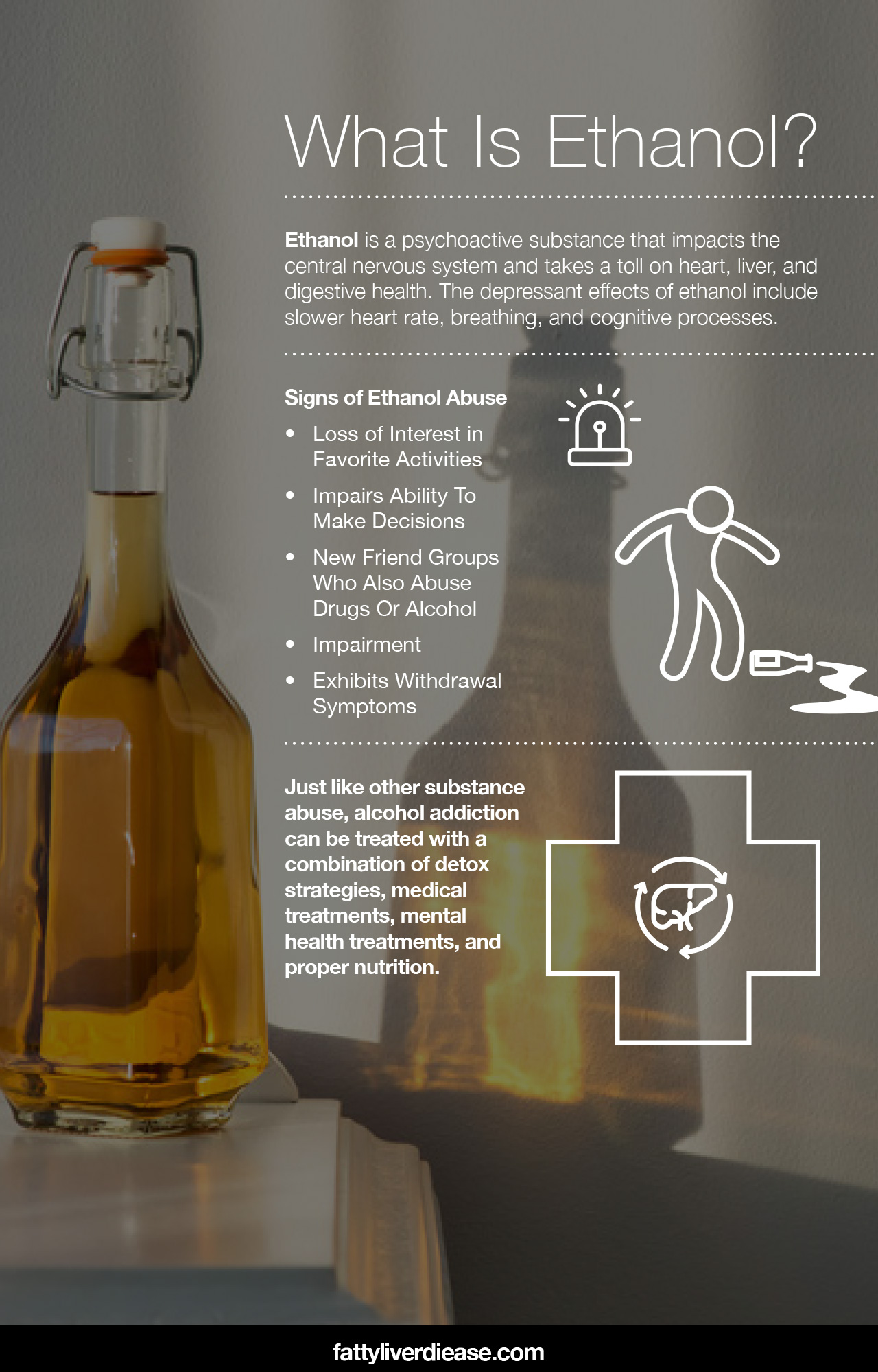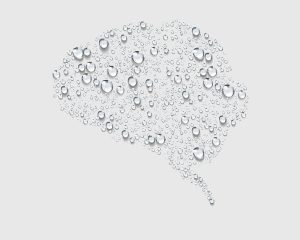When you drink an alcohol, the active ingredient that causes all the effects is ethyl alcohol or ethanol. Chemically, ethanol is a type of alcohol that is present in beverages like beer, wine, and spirits. Ethanol abuse is another term to describe alcohol abuse, and affects millions of Americans.
According to the National Survey on Drug Use and Health, nearly 14.5 million Americans suffer from alcohol use disorder, as of 2019. (1) If you think you or a loved one may be suffering from ethanol abuse, then you’ve come to the right place. Read on to find out more about ethanol abuse, the effect of ethanol abuse on health, and treatment.
What Is Ethanol and How Does It Affect the Body?
Before we go further, let’s first go over what ethanol is and how it impacts the body. Ethanol is a compound that consists of an ethyl group and a hydroxyl group and is often chemically designated as EtOH. An ethyl group contains two carbon atoms and five hydrogen atoms, while a hydroxyl group contains an oxygen atom bonded to a hydrogen atom. Ethanol is the only type of alcohol that is safe for human consumption in small, controlled amounts. However, in high amounts, ethanol consumption can be life-threatening.
The ethanol that we consume is commonly produced by fermenting and distilling wheat, barley, or other grains. Grain alcohols include beer, vodka, and whiskey. Wine is produced from fermenting grapes.
Ethanol has a depressant effect on the body, which means that it lowers the activity of the central nervous system. Alcohol interferes with the normal activity of the central nervous system and slows down neurotransmission. The depressant effects of alcohol include slower heart rate, breathing, and cognitive processes.
What Is Ethanol Abuse?
Ethanol abuse describes the unhealthy consumption of alcohol. The National Institute on Alcohol Abuse and Alcoholism describes alcohol use disorder as the consumption of alcohol without control and to the detriment of work, family, and other activities. (2)
Alcohol use disorder can be characterized by binge drinking or heavy drinking. Binge drinking can be defined as the consumption of enough alcohol in one sitting to cause your BAC to rise above 0.08. Heavy drinking entails regularly drinking more than the recommended daily limit of drinks per day, which is two drinks daily for men and one for women.
Health Effects of Ethanol Abuse
Ethanol abuse has both short-term and long-term impacts on the body and the mind. In the short term, high levels of ethanol intoxication may cause serious impacts on the body and brain. Here are a few examples of how impairment increases with increasing BAC.
- BAC around 0.02: A BAC of 0.02 is the lowest BAC that may exhibit detectable effects. You may feel slightly more relaxed or have a better mood.
- BAC up to 0.08: A BAC of 0.08 is the legal limit in many states. A BAC up to 0.08 may cause mild impairment and relaxation.
- BAC between 0.08 and 0.20: As the BAC rises past the legal limit, an individual loses more ability to coordinate movements and make decisions. Slurred speech is also common.
- BAC of 0.25: At this point, the level of intoxication reaches alcohol poisoning. Confusion, nausea, and vomiting set in.
- BAC of 0.40 and above: At this point, the individual has lost consciousness and enters a coma. Death may occur due to the cessation of breathing and heart function.
In the long-term, chronic and excess alcohol ingestion can cause numerous health problems. Here are a few key areas of your health that may be affected over time.
Liver
The liver is susceptible to alcohol-related damage because it is responsible for processing and metabolizing alcohol. Drinking a high amount of alcohol over time can interfere with the liver’s function, and lead to the development of fatty liver disease. Alcoholic fatty liver disease is characterized by the accumulation of fat particles within hepatocytes, or liver cells. When left untreated, fatty liver disease may progress to more serious forms of liver disease such as alcoholic steatohepatitis, liver fibrosis, and liver cirrhosis. Eventually, these conditions may lead to liver failure.
Heart
If you chronically drink alcohol in excess, you may be at a higher risk of developing heart disease. Ethanol use interferes with the electrical activity that causes the heart to beat regularly, increasing the risk of developing arrhythmias and irregular heartbeats. Drinking in large amounts can over time put you at risk for developing cardiomyopathy, which is a condition characterized by a weakened heart muscle. When the heart muscle is weaker, it is unable to efficiently pump blood throughout the body.
Immune System
The immune system is responsible for protecting the body from infection and malfunctioning cells. Ethanol is known to be an immune system suppressant and causes immune system dysfunction. Drinking large amounts of ethanol prevents the immune system from working as it should. If you drink too much, the immune system is not able to launch an attack against invading pathogens like bacteria and viruses. Ethanol use is often associated with increased inflammation and more frequent colds and infections.
Pancreas
The pancreas is responsible for producing enzymes that facilitate digestion and metabolism. The pancreas also produces and releases insulin, which helps the body utilize glucose in the bloodstream for energy. Heavy drinking and ethanol abuse can damage the pancreas and cause significant inflammation, leading to a condition called pancreatitis.
Brain
Long-term alcohol use and alcohol dependence can have serious consequences for brain function. Chronic exposure to ethanol can facilitate the death of brain cells and affect cognitive function. The National Institute on Alcohol Abuse and Alcoholism provides information on how chronic alcohol abuse can lead to brain damage, often indicated by brain shrinkage in imaging exams. (3) Moreover, excessive and chronic alcohol use can lead to Wernicke-Korsakoff Syndrome or wet brain, which develops as a result of alcohol-induced thiamine deficiency and causes symptoms like memory issues and coordination problems.
Digestive System
The digestive system is severely impacted by chronic alcohol consumption. Ethanol irritates the membrane of the digestive tract and can cause inflammation, making it more likely to experience acid reflux or nausea. Excess alcohol consumption also inhibits the absorption of nutrients like B vitamins, leading to nutrient deficiencies.
Signs of Ethanol Abuse
If you or a loved one is suffering from ethanol abuse, then there are some common warning signs and symptoms.
Loss of Interest in Favorite Activities
Many individuals struggling with alcohol use disorder lose interest in activities that they once enjoyed. Drinking alcohol may become the main priority, replacing hobbies and other interests.
Poor Decisions
Individuals suffering from ethanol abuse often drink compulsively and in excessive amounts, which impairs their ability to make decisions. An individual with ethanol abuse may make decisions that put themselves or others in danger.
New Friend Groups
An individual who abuses ethanol will usually seek out friends who also abuse drugs or alcohol. Other relationships may be neglected.
Impairment
Intoxication with alcohol will likely be visible when an individual struggles with ethanol abuse. For example, you may notice slurred speech, stumbling, agitation, irrational decisions, and vomiting.
Withdrawal Symptoms
An individual who is physically dependent on alcohol will exhibit withdrawal symptoms. Shaking and anxiety may occur within as little as a few hours of not drinking. Over time, symptoms will become more severe. Keep in mind that uncontrolled withdrawal from alcohol may require medical attention.
Healing from Ethanol Abuse
Treatment for ethanol abuse is multifactorial and requires treating both the physical and psychological factors that are at play. Here we go through the step-by-step process for healing from ethanol abuse.
1. Acknowledging the Problem
If the problem isn’t recognized, then it’s impossible to fix it. The first critical step in healing from alcoholism or ethanol abuse is realizing that your patterns of alcohol consumption are unhealthy. Understanding the problem and deciding to heal are the important driving factors for change.
2. Physical Detox from Alcohol
If you abuse ethanol, there is a high likelihood that you are physically dependent on alcohol. This means that all of your cells and organs have adjusted to functioning while flooded with alcohol. Stopping ethanol consumption cold turkey may put your health in jeopardy.
Instead, talk to your healthcare provider and come up with a plan for the best way to detox from alcohol. If you prefer to detox from alcohol at home, you may decide to gradually taper your intake of ethanol over a period of days or weeks. It’s a good idea to also visit your physician regularly, on an outpatient basis, to ensure that you’re on track with your detox process.
In cases of severe ethanol abuse in which serious health conditions are present, it is best to detox from alcohol in the care of medical professionals in a hospital or other inpatient clinical setting. Withdrawal symptoms can be severe and include shaking, anxiety, restlessness, agitation, sweating, and tremors. In severe cases, alcohol withdrawal symptoms include seizures and can be life-threatening.
3. Restoring Good Nutrition
Consuming high quantities of ethanol on a regular basis is associated with nutrient deficiencies.
Individuals who abuse ethanol tend to also tend to consume a diet lacking in nutrition and balance. Moreover, ethanol itself can inhibit the body from utilizing any nutrients you do consume. Ethanol irritates the digestive system and prevents the proper absorption of macronutrients and micronutrients. Deficiency in B vitamins is commonly seen in individuals with alcoholism. Severe ethanol abuse can result in a syndrome called Wernicke-Korsakoff syndrome, commonly known as wet brain. Wernicke-Korsakoff syndrome results from vitamin B1 or thiamine deficiency and causes serious cognitive repercussions and symptoms like memory loss and confusion.
Now that ethanol has been cleared out of your diet, it’s the perfect time to balance your eating habits and nourish your body with healthy, whole foods. Here are a few tips for getting your nutrition back on track:
- Fruits and vegetables: Fruits and vegetables are a critical component of a healthy diet. Eating an abundance of fruits and vegetables can help fight against ethanol-induced oxidative stress and inflammation while promoting tissue repair.
- Omega-3 fatty acids: Omega-3 fatty acids are required for optimal brain health and function. Consumption of ethanol strips the brain of anti-inflammatory fatty acids. You can replenish omega-3 fatty acids in the body by consuming foods like salmon, mackerel, sardines, chia seeds, flaxseeds, walnuts, and pecans. Other types of healthy fats are important for nourishing the body as well. For an abundance of healthy polyunsaturated and monounsaturated fats, reach for foods like almonds, peanuts, avocados, pumpkin seeds, and olive oil.
- High-quality protein: High-quality protein contains amino acids, which are vital for producing neurotransmitters, hormones, and muscle tissue. Eating plenty of high-quality protein on a daily basis ensures that you’re getting the essential amino acids you need to combat alcohol-induced muscle wasting and cognitive effects. You can get optimal ratios of essential amino acids from healthy foods like eggs, low-fat cheese, nonfat yogurt, chicken breast, and fish.
- Taking supplements: In the case of nutrient deficiencies caused by ethanol abuse or other factors, it can be challenging to ensure that you’re getting all of the nutrients that you need from food alone. Consider taking supplements like a multivitamin, vitamin B complex, essential amino acids, and fish oil. It’s a good idea to talk to your doctor and a nutritionist to make sure that you’re taking all of the right steps to support your health.
4. Managing Alcohol-Related Conditions
Chronic ethanol abuse can cause significant damage to organ systems and result in certain diseases. One of the most common diseases associated with ethanol abuse is liver disease, in the form of fatty liver disease, steatohepatitis, fibrosis, or cirrhosis.
You will require different methods of treatment, depending on the stage and progression of liver disease you have. For example, fatty liver disease can often resolve on its own in response to quitting ethanol consumption. Liver cirrhosis is a little more tricky to treat and may involve preserving remaining healthy tissue, rather than healing scarred tissue.
5. Mental Health Care
Mental health care is vital for reaching full recovery from ethanol abuse. Mental health care can help determine any underlying psychological factors that may drive your desire to drink. Mental health practitioners and addiction specialists can help navigate challenges like trauma and mental illness, while also helping you cope with cravings and equipping you with tools to manage substance use disorders and remain abstinent from your drug of choice.
Mental health care providers may also provide grief counseling and strategies for managing high functioning depression and high functioning anxiety.
6. Finding a Support Group
It’s critical to realize that you’re not on this journey alone. So many Americans in the United States are struggling with ethanol abuse and are striving to get clean. Finding others that can support you and relate to your journey is crucial for success. Many individuals find support with groups like Alcoholics Anonymous, which holds regular meetings, allows individuals to share their experiences, and shares tools for beating alcoholism.
The Substance Abuse and Mental Health Services Administration is an excellent resource for finding support with alcohol abuse, drug abuse, behavioral health issues, and more. https://www.samhsa.gov/find-help/national-helpline
7. Changing Your Environment
When recovering from ethanol abuse, changing your environment is crucial for supporting sobriety. Creating a new surrounding can help break unhealthy habits and distance from individuals who encourage unhealthy drinking patterns. Inpatient treatment programs also provide a healthy and therapeutic setting for individuals recovering from alcohol abuse.
Tips for Managing Your Alcohol Consumption
Unfortunately, unhealthy drinking patterns are encouraged and accepted by today’s society and culture. You may not meet the criteria for alcohol abuse, but maybe you drink more than you should and more frequently than you should. Here are a few tips for curbing your alcohol intake and maintaining a healthy, moderate pattern of drinking.
Drink Slowly
The more slowly you drink, the more slowly alcohol enters your bloodstream. Stick to the drinking rate of about one drink per hour. At this rate, your liver can keep up with the ethanol detoxification process, preventing your blood alcohol levels from getting too high.
Substitute Non-Alcoholic Drinks for Alcoholic Beverages
You don’t have to drink alcohol to enjoy a night out with your friends. Unfortunately, it’s common to feel social pressure to drink alcohol. To help manage social pressure, carry a fun non-alcoholic drink in your hand. Mocktails and non-alcoholic beer and wine are great options that taste good without making you feel like you’re missing out.
Alternate Water and Alcoholic Beverages
When you are drinking, alternate water and drinks to help cut back on the amount of alcohol you’re drinking. Alternating water and alcohol can help you stay hydrated while giving your liver the opportunity to process the ethanol you’ve consumed.
Find Friends Who Share Your Views
It’s a lot easier to cut back on the amount of alcohol you consume when you surround yourself with others who have the same views. Friends who are abstinent from alcohol and drug use will support you in your decision to cut back on drinking and keep you accountable.
On the flip side of that coin, you may find it necessary to limit your time spent with friends who don’t respect your decision to stay sober. Spending time with people who drink too much and encourage you to do the same increases your chances of engaging in unhealthy drinking patterns.
Start a New Hobby
Have you always wanted to learn how to play piano, knit a scarf, speak a new language, or get involved in photography? There’s no better time than now! Plus, taking up a new hobby diverts your time and attention toward activities that don’t involve drinking. Spending your time constructively and learning new hobbies can help curb your drinking habits.
Change the Type of Alcohol
The form of alcohol you drink may be contributing to your drinking patterns. Drinking high-proof alcohol like vodka, whiskey, and rum can increase the likelihood of ingesting too much ethanol and increasing your BAC to dangerous levels. Instead, try drinking beer or wine, which contain lower concentrations of alcohol.
Journal
Journaling can be a helpful skill in keeping track of and monitoring your drinking habits. Take the time to write a couple of lines about what you’re doing that day and how you’re feeling. You may notice that you have better days when you stay sober. Journal entries written when you’re hungover can be excellent reminders for why you want to curb your drinking habits.
Everything You Need to Know About Ethanol Abuse: Conclusion
Ethanol abuse is a common disorder that affects millions of Americans. Ethanol is a psychoactive substance that impacts the central nervous system and takes a toll on heart, liver, and digestive health. Luckily, substance use disorders like alcohol addiction can be treated with a combination of detox strategies, medical treatments, mental health treatments, and proper nutrition. Establishing healthy routines and hobbies and finding a support network can reinforce sobriety and help improve your health and quality of life.

References:
(1) https://www.samhsa.gov/data/data-we-collect/nsduh-national-survey-drug-use-and-health
(2) https://www.niaaa.nih.gov/publications/brochures-and-fact-sheets/understanding-alcohol-use-disorder























